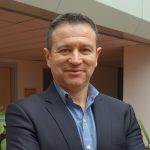Virtual Only
2-High-Accuracy Angle Metrology
Tanfer Yandayan, TUBITAK UME
Friday, October 7, 2022
7:00AM-11:00AM (PDT USA)
High-accuracy angle metrology is a key technology for scientific and industrial applications of high value, enabling countries to be globally competitive. High-accuracy angle measuring devices – such as angle encoders, angle interferometers, small angle generators and autocollimators – are extensively used in various applications where high precision is demanded and are calibrated by national metrology institutes (NMIs) in order to ensure the traceability to SI unit of plane angle, radian (rad). Besides, high accuracy angle measurement-generation, and the control of angle tilting units at the nanoradian uncertainty level are essential to numerous applications ranging from astrometry, space missions, and scientific experiments to industrial applications. For example, the autocollimators have recently become very popular since autocollimator-based slope measuring profilers have proven to be capable of characterizing ultra-precise X-ray optical components for the inspection of ultra-precise X-ray optical components of today; particularly for applications in Synchrotron Radiation (SR) and Free Electron Lasers (FELs). Use of autocollimators for the ultra-precise measurement of optical surfaces using scanning techniques (such as inspecting the quality of SR optics) requires task oriented investigations and more detailed calibration to obtain better accuracies (than those stated by the manufacturers). This is only possible after individual calibration of the devices customized to the specific measuring tasks, proper use of calibration data and investigation results. The idea of “task specific calibration”, “task oriented investigations” and “use of these information” for the devices and the standards is the key point for high-accuracy angle metrology. The aim of this tutorial is to provide the participants with the information obtained on the recent research work of high-accuracy angle metrology aiming for participants to be able to use the angle measurement devices and standards for the high precision applications and achieve the best measurement uncertainties. After introduction of the angle measurement devices, standards and the measurement methods, the tutorial will focus on “how to achieve high accuracy angle measurements” by providing/using information on how to push the limits of the devices (achieving better than their specs), requesting proper calibration data and its use, considering disturbances (due to differences of environment and applications between calibration and use – particularly those realized in the recent research work) and practical tip/tricks gained in the 25 years practical experience of the instructor in the angle metrology. The examples will be given from the latest Angle metrology research project supported by European Commission (conducted by the consortium members consisting of world leading angle device manufacturers and NMIs in angle metrology) and the recent research work of the instructor. Practical tip/tricks will be provided to show how to achieve the best measurement uncertainties properly using angle metrology devices and their calibration data. The subjects to be covered are as follows:
- Angle measuring instruments and standards: Following to information on requirements for high-accuracy angle metrology with some examples, devices for this purpose will be introduced considering the accuracy levels. Important issues will be presented to use them for high accuracy angle metrology applications.
- Calibration of angle measurement devices and standards: Calibration issues will be discussed for those using the certified calibration values and also for those intend to do or perform the calibrations. In order to achieve required accuracy levels, parameters and also the selection of the methods for calibration will be presented. Examples will be given on commercial devices such as angle interferometers integrated with rotary tables, autocollimators used for optical profilometry, rotary tables fitted in Machine Tools or Gimbals as well as reference rotary tables used for primary calibrations. Comparison of the calibration methods according to accuracy requirements will be discussed.
- High accuracy Angle metrology applications and error sources: Use of the devices and standards for High accuracy Angle metrology applications will be discussed and the error sources preventing the achievements will be presented for each individual device and standards. Investigation results taken from recent research work will be presented particularly on use of autocollimators in optical profilometry.
- Error separation methods: Two different error separation methods will be presented complementing each other. One is for determination of error sources in the large measurement range e.g. 0-360 degrees. In fact it is used for practical realization of the SI unit radian by subdivision of the full circle (2π rad). The other one, shearing method recently developed for investigation of error sources in short measurement ranges provides excellent performance for determination of interpolation errors with uncertainties down to 0.001″ (5 nrad). Examples will be given using recent experimental research work. Uncertainty analyses: Examples covering angle measurements devices and standards will be given. Uncertainty parameters will be discussed.
- Practical tip/tricks and things to watch out for: The issues for use of angle metrology devices at the best performance reaching high accuracy measurements and how to cope with these will be discussed.

Tanfer Yandayan is a Chief Research Scientist in TUBITAK UME, National Metrology Institute of Turkey. Tanfer joined TUBITAK UME in 1997 after completing his PhD degree in Mechanical Engineering at the University of Manchester, UK. His research areas are interferometric and contact dimension measurements, geometrical errors, coordinate metrology, machine tool metrology and angle metrology. He headed the dimensional lab of TUBITAK UME for 15 years and worked for integration of TUBITAK UME to international metrology system being first international representatives. He is now doing research in dimensional metrology and has recently completed coordination of Angle Metrology project in which high level challenging issues for nanoradian-angle metrology were tackled with international consortium of 16 organisations. He is an associate professor in
Mechanical Engineering and teaches Manufacturing Metrology course at Sabanci University and metrology courses in MSc Metrology programme at Gebze Technical University. He currently works for the projects supported by European Commissions and perform continuous research work for advanced angle metrology applications.

